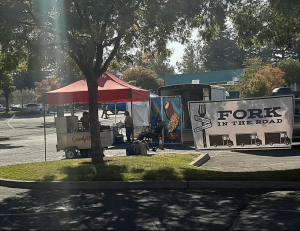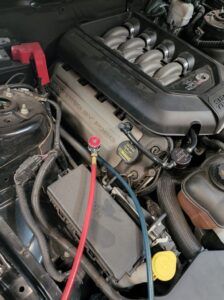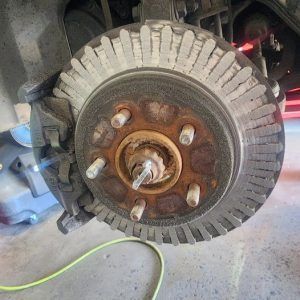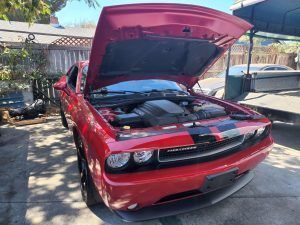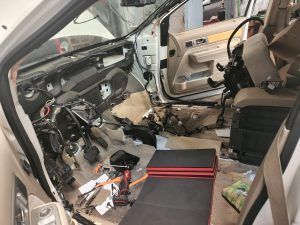Why It’s Essential for Your Vehicle’s Safety and Performance
Brake pads are one of the most critical components of your vehicle’s braking system. They play a fundamental role in ensuring safe, reliable stopping power by converting kinetic energy into thermal energy through friction. However, over time, brake pads wear down due to constant friction with the brake rotors. Replacing worn-out brake pads is essential for maintaining your vehicle’s safety, performance, and overall longevity. Ignoring this crucial maintenance task can lead to serious consequences, including diminished braking efficiency, increased stopping distances, and potential brake system failure.
In this comprehensive guide, we’ll explore why it’s necessary to replace your brake pads, how they work, signs that indicate they need replacing, and the dangers of neglecting brake pad maintenance. Additionally, we’ll discuss the different types of brake pads available and how to choose the right ones for your vehicle.
1. How Brake Pads Work
Brake pads are a key part of the disc brake system, which is commonly found in modern vehicles. This system consists of several components:
- Brake Pedal: The driver presses the brake pedal to initiate the braking process.
- Master Cylinder: The brake pedal activates the master cylinder, which generates hydraulic pressure in the brake lines.
- Brake Calipers: The hydraulic pressure forces the brake calipers to clamp the brake pads onto the brake rotors.
- Brake Rotors: The brake rotors, attached to the wheels, slow down or stop the vehicle when the brake pads create friction against them.
- Brake Pads: These pads create friction with the rotors, converting the vehicle’s kinetic energy into heat, which slows or stops the wheels.
Over time, the friction material on the brake pads wears down, reducing their effectiveness. Regularly replacing worn brake pads is crucial to ensuring optimal braking performance and preventing damage to other components of the braking system.
2. Why You Need to Replace Your Brake Pads
a) Ensuring Safety on the Road
The primary reason for replacing brake pads is to ensure your safety and the safety of others on the road. Worn brake pads reduce your vehicle’s ability to stop quickly and effectively, especially in emergency situations. Replacing brake pads when they are worn prevents accidents caused by extended stopping distances or brake failure.
b) Preventing Damage to Brake Rotors
When brake pads wear down, the metal backing plate can come into direct contact with the brake rotors. This metal-on-metal contact not only reduces braking efficiency but also causes severe damage to the rotors, leading to expensive repairs or replacements. By replacing your brake pads in a timely manner, you protect the rotors from unnecessary wear and extend their lifespan.
c) Maintaining Optimal Braking Performance
Brake pads are designed to provide consistent friction for smooth and controlled braking. Worn-out pads compromise this consistency, leading to uneven braking, vibrations, and decreased control over your vehicle. Regularly replacing brake pads ensures your braking system performs at its best, maintaining your vehicle’s overall stability and handling.
d) Reducing Repair Costs
Replacing auto brake pads is relatively inexpensive compared to the cost of auto repair or repairing or replacing other brake system components, such as rotors, calipers, or the master cylinder. Neglecting brake pad maintenance can lead to more extensive damage, resulting in higher repair costs. Preventive maintenance by replacing brake pads helps you avoid costly repairs in the long run.
e) Improving Fuel Efficiency
While it may not be immediately obvious, worn brake pads can negatively impact your fuel efficiency. When brake pads are not functioning properly, the braking system may require more effort to slow down the vehicle, causing additional drag and resistance. Replacing worn pads helps maintain smoother braking, reducing unnecessary energy loss and improving fuel economy.
3. Signs That Your Brake Pads Need Replacing
Recognizing the early signs of worn brake pads can help you replace them before they compromise your vehicle’s safety. Here are some common indicators that your brake pads may need to be replaced:
a) Squealing or Screeching Noise
A high-pitched squealing or screeching noise when applying the brakes is often the first warning sign of worn brake pads. Many brake pads have a built-in wear indicator that produces this noise to alert you when it’s time for a replacement.
b) Grinding or Metal-on-Metal Sound
If you hear a grinding noise when braking, it may indicate that the brake pads are completely worn down, and the metal backing plate is making contact with the rotor. This can cause severe damage to the rotors and requires immediate attention.
c) Reduced Braking Performance
If your vehicle takes longer to stop or the brake pedal feels less responsive, it’s likely that your brake pads are worn and need to be replaced. Reduced braking performance can be dangerous, especially in emergency situations.
d) Vibrations or Pulsations in the Brake Pedal
A vibrating or pulsating brake pedal when braking is a sign of uneven brake pad wear or warped rotors. Replacing worn brake pads can help resolve this issue and restore smooth braking.
e) Visual Inspection
You can visually inspect your brake pads by looking through the wheel spokes. If the pads appear to be less than 3 millimeters thick, it’s time to replace them. Some brake pads also have wear lines that indicate when they need to be changed.
f) Brake Warning Light
Many modern vehicles have a brake warning light on the dashboard that illuminates when the brake pads are worn or if there’s a problem with the braking system. If this light comes on, have your brakes inspected immediately.
4. The Risks of Not Replacing Worn Brake Pads
Failing to replace worn brake pads can lead to several serious consequences, including:
a) Brake System Failure
Ignoring worn brake pads can result in complete brake system failure, leaving you unable to stop your vehicle safely. This increases the risk of accidents and endangers both you and other road users.
b) Increased Stopping Distances
Worn brake pads reduce the friction needed to stop your vehicle, leading to longer stopping distances. This can be especially dangerous in emergency situations or when driving on wet or slippery roads.
c) Damage to Other Brake Components
When brake pads are not replaced in time, they can cause significant damage to other brake system components, such as rotors, calipers, and brake lines. This leads to more extensive and expensive repairs.
d) Reduced Vehicle Control
Uneven or inadequate braking caused by worn pads can compromise your ability to control the vehicle, particularly during hard braking or on uneven terrain. This increases the likelihood of losing control and having an accident.
e) Higher Repair Costs
Neglecting brake pad replacement can lead to costly repairs or even a complete brake system overhaul. Regular brake pad replacement is a cost-effective way to avoid these expenses.
5. Types of Brake Pads and Their Advantages
There are several types of brake pads available, each with unique advantages and disadvantages. Understanding these options can help you choose the right brake pads for your vehicle:
a) Organic Brake Pads
Organic brake pads, also known as non-asbestos organic (NAO) pads, are made from a mixture of materials like rubber, glass, and Kevlar bound together with resin.
Advantages:
Affordable and widely available
Quiet operation with minimal noise
Soft material, reducing wear on rotors
b) Semi-Metallic Brake Pads
Semi-metallic brake pads contain a combination of metal fibers and organic materials, offering a balance between performance and durability.
Advantages:
- Excellent braking performance
- Durable and long-lasting
- Better heat dissipation
c) Ceramic Brake Pads
Ceramic brake pads are made from ceramic fibers and other materials, offering superior performance and longevity.
Advantages:
- Quiet operation with minimal dust production
- Longer lifespan and consistent performance
- Excellent heat resistance
6. How Often Should You Replace Brake Pads?
The frequency of brake pad replacement depends on several factors, including driving habits, road conditions, and the type of brake pads used. On average, brake pads should be replaced every 30,000 to 70,000 miles, but it’s essential to follow your vehicle manufacturer’s recommendations and have regular brake inspections to determine the best replacement interval.
Conclusion
Replacing your brake pads is a vital part of vehicle maintenance that ensures your safety, preserves your braking system, and prevents costly repairs. By recognizing the signs of worn brake pads and replacing them promptly, you can maintain optimal braking performance and extend the life of other brake components. Investing in regular brake maintenance not only enhances your vehicle’s safety but also improves its overall performance and longevity.
